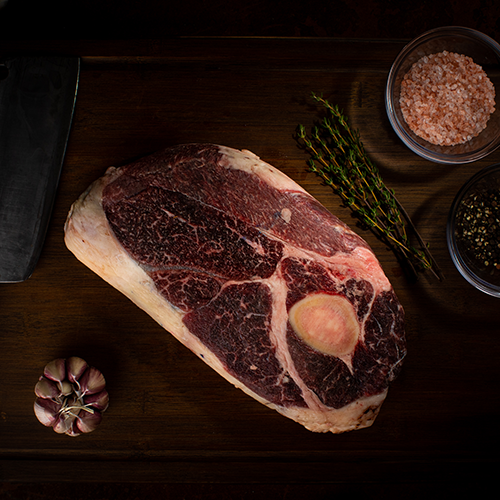[vc_row css=”.vc_custom_1600724598760{margin-right: 0px !important;margin-left: 0px !important;}”][vc_column][ultimate_heading main_heading=”Taste & Tenderness” alignment=”left” main_heading_margin=”margin-bottom:30px;”][/ultimate_heading][vc_column_text]
Akaushi beef is known for its taste and tenderness. Yet, not all cuts from the same animal have the same profile, nor do all cooks have the same skills. The key is to know the cuts of meat and their appropriate cooking methods. Here are a few hints:
What makes a cut of beef inherently tender or tasty is the purpose of the muscle – how much exercise it received – and the ratio of connective tissue and fat to muscle. Typically, the meat with the most beef flavors are going to be those that are used most often by the animal. Since exercise for a cow consists of walking, these are usually found in the chuck, round, brisket, or shanks. The meat with the most tenderness, on the contrary, are structural muscles, those that are used more for support than movement. These muscles are typically found in the rib and the loin, which support the spine.
[/vc_column_text][/vc_column][/vc_row][vc_row][vc_column][ultimate_heading main_heading=”Typical Cuts for Optimal Taste and Tenderness” heading_tag=”h3″ main_heading_font_family=”font_family:|font_call:” main_heading_margin=”margin-bottom:30px;”][/ultimate_heading][/vc_column][/vc_row][vc_row][vc_column width=”1/4″][/vc_column][vc_column width=”1/4″][ultimate_info_table design_style=”design04″ color_scheme=”custom” color_bg_main=”#e1d3b6″ color_txt_main=”#001837″ color_bg_highlight=”#bda300″ color_txt_highlight=”#001837″ package_heading=”Taste” package_sub_heading=”Rich Beefy Profile” heading_font_color=”#001837″ subheading_font_color=”#7b7167″ features_font_color=”#001837″ heading_font_family=”font_family:Montserrat|font_call:Montserrat” heading_font_style=”font-weight:bold;” css_info_tables=”.vc_custom_1600724423112{padding-right: 10px !important;padding-left: 0px !important;}” features_font_family=”font_family:Merriweather Sans|font_call:Merriweather+Sans” subheading_font_family=”font_family:Montserrat|font_call:Montserrat”]
Chuck Roast
Shoulder Roast
Shank
Brisket
Rump Roast/Steak
Top/Bottom Round
Flank Steak
Eye of Round
Short Ribs
[/ultimate_info_table][/vc_column][vc_column width=”1/4″][ultimate_info_table design_style=”design04″ color_scheme=”custom” color_bg_main=”#e1d3b6″ color_txt_main=”#001837″ color_bg_highlight=”#bda300″ color_txt_highlight=”#001837″ package_heading=”Tenderness” package_sub_heading=”Juicy & Marbled” heading_font_color=”#001837″ subheading_font_color=”#7b7167″ features_font_color=”#001837″ heading_font_family=”font_family:Montserrat|font_call:Montserrat” heading_font_style=”font-weight:bold;” css_info_tables=”.vc_custom_1600724415393{padding-right: 0px !important;padding-left: 10px !important;}” features_font_family=”font_family:Merriweather Sans|font_call:Merriweather+Sans” subheading_font_family=”font_family:Montserrat|font_call:Montserrat”]
Filet Mignon
Ribeye Steak
Standing Rib Roast
NY Strip Steak
Coulotte
T-bone Steak
Porterhouse Steak
Sirloin Steak
Tri-Tip Roast/Steak
[/ultimate_info_table][/vc_column][vc_column width=”1/4″][/vc_column][/vc_row][vc_row css=”.vc_custom_1600724610144{margin-right: 0px !important;margin-left: 0px !important;}”][vc_column][vc_column_text]
While the list above is a good starting point for getting to know cuts of beef, craft butchers are putting more focus on how to cut and dry-age meat to get the best taste and texture profile for their customers. For example, skilled butchers can trim around connective tissue to get tender Tucson steaks from the round and tender Delmonico steaks from the chuck. Likewise, the dry-age process can naturally add deeper, concentrated flavors to the tender cuts such as the rib-eye or t-bone.
Cooking techniques also play a major part in the taste-texture profile. Each cut needs its own treatment. As a general rule, the most tender cuts with the least amount of connective tissue and highest concentration of marbling should be cooked quickly at high and dry temperatures. This allows the meat to cook just enough to release flavor. The tougher cuts, on the other hand, typically have more connective tissue, which need slow and low heat to break down. Typically braising just below boiling is what gives stews and roasts their silky feel.
[/vc_column_text][/vc_column][/vc_row][vc_row css=”.vc_custom_1600724620511{margin-right: 0px !important;margin-left: 0px !important;}”][vc_column][ultimate_heading main_heading=”Akaushi Difference” alignment=”left” main_heading_margin=”margin-bottom:30px;”][/ultimate_heading][vc_column_text]
Due to the genetic marbling, better living conditions, lower stress, and quality feed, Akaushi has more taste and tenderness throughout the body than typical beef giving chefs and steak-lovers more cooking options. HLC Meats provides general cooking recommendations on each product. Also refer to our handling guide for more information.
[/vc_column_text][/vc_column][vc_column][/vc_column][/vc_row]




